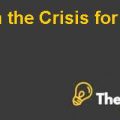
Gulf Bank rebuilding a bank Ivey Case
Introduction
Corporate governance and monitoring is essential to any large institutions’ success. Gulf Bank failed to provide corporate governance and thus suffered a financial crisis. In 2009 the new CEO (Michel Accad) is trying to bring about changes in the way the bank functions and governs itself.
The financial loss was a result of the internal and external problems faced by the company. By 2008 many clients had walked away from their currency derivatives losses which finally brought the deep routed problems under the spotlight.
The bank was established in 1960 and provided services in lending and corporate finance services. From 2003 to 2007 the bank expanded and enjoyed tremendous amounts of success. With its new ATM’s, signed strategic agreements with corporations, and 41 branches Gulf Bank had established a strong hold in the country.
Even in 2008 when the world faced a financial crisis, the bank for the first half of the year did not face any repercussions, even though competing financial institutions were affected greatly. According to a company official, the bank did not face the effects of the financial crisis, and was enjoying a profitable streak. It was until 2008 that grave problems became evident which led to the Gulf Bank becoming the only bank in Kuwait that required government bailout.
Problem Identification and cause analysis
The problem relates to the issue of proper corporate governance and sustainable risk management. The focal area that requires improvement is the implementation of corporate governance laws in an effective manner. This is a deep routed problem.
The major problems that resulted from bad corporate governance were also related to bad management of credit. In 2007, a client had bought currency derivatives, which anticipated that the Euro would rise against the US dollar. However, since the US dollar rose a massive loss of KD 200 million was incurred. This was a result of bad forecasting and bad governance. This is result of bad risk management and improper inspection of contracts and risk diversification, as evident in the case. The bank should have followed its guidelines and closed the position when the losses had reached KD 20 million, but delays in adopting and implementing contingency measures led to losses skyrocketing.
Even though guidelines of dealing with such situations were available, negligence of behalf of the management led to matter getting out of hand. The company did not have a clear cut corporate governance committee and this was an internal problem. Furthermore due to lack of inspection and evaluation, Gulf Bank’s management wasn’t able to foresee and predict future problems. The contracts had been completely unmonitored. The bank had a low cost to income ratio. Even though a low cost to income ratio presents a positive situation, this too was a signal of the internal problems that prevailed. As a result of this low cost to income ratio, the bank ended up spending less on monitoring and information technology. Information technology is an essential tool for monitoring and sharing of core company information.
Other factors that added to the crisis face by Gulf Bank were the presence of non-performing loans and collateral management. The company used assets instead of cash flow as collateral. When the prices of collateral fell down the clients had zero cash flow and were unable to pay the interest. This resulted in massive losses faced by the Gulf Bank.
As a result, investor confidence was low and the share price fell to KD0.30 per share. With deteriorating goodwill and decreasing investment attractiveness, the bank faced value loss.
One of the other problems faced by Gulf Bank was unsuccessful restructuring and change. With high employee turnover of senior management and controllers a new system of corporate governance had to be introduced. Bringing change to organization is a long and troublesome task as change acceptability is difficult in organizations.
There was also miscommunication between the directives from the senior management and the local managers. This resulted in establishment of different goals. While one manager was trying to maximize customer service, another was trying to maximize revenue per customer. For success all stakeholders should be in one strategic direction rather than multiple ones.
Initially Gulf Bank adopted a centralized system within the organization in terms of decision making as all decisions pertaining to credit approvals and capital budgets were made by the chairman. Moving from a centralized structure to a decentralized one requires training of the entire workforce in terms of dealing with the pressure that comes from having increased amount of power. Since great power calls for great responsibility, the senior management needed to plan for training; a fact which was ignored.
Another main problem was absence of culture that promoted constant and elaborate risk management which led to the bad situation, the bank was currently in.
A factor that added to the bank’s current failure was the fact that the senior management overcompensated or undercompensated their employees’ worth. During periods of growth and success, employees received flamboyant appreciation and recognition, which led them to believing that current practices undertaken needed no further improvements. However when problems started to arise, the same executives, started pointing fingers and blaming their staff for the losses. Not only did this create doubts regarding previously practiced strategies but also decreased motivation levels, created job insecurities and lowered morale.
The regulatory environment also needed some improvement in terms of risk management and corporate governance. According to exhibit 5 and 6 Kuwait does not have a market regulator or capital market authority. KSE lacks the number of laws and regulations relating to corporate governance. They have not fully adapted international best practicing standards for this management. There is lack of human capacity to monitor all accounting standards. Listed companies are not required to share information that may affect their business so forecasting cannot be done. There is lack of timely disclosure policies which needs to be there for better regulation. The laws do not explicitly stop market manipulation, plus insider trading is also allowed. All of this basically means that there are not enough stringent checks and balances imposed by a regulatory body. Due to lack of accountability, probability for chances of failure of financial organizations increases greatly.
Overall these were the reasons that led to the problem. The non-performing loans and derivative loss were just the symptoms of a deep routed problem of corporate governance and direction.
This is just a sample partial case solution. Please place the order on the website to order your own originally done case solution












